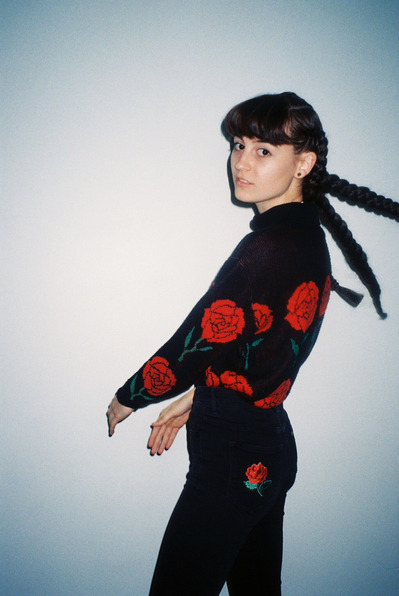Faye Webster: The Best of What’s Next
Aside from the surface incongruity of a rap label putting out an album of gentle, lovesick twang, Faye Webster’s choice of collaborators betrays her unwillingness to stay in a box.
Top photo by Eat Humans. All others by Pierre Pastel Music Features Faye Webster
If you didn’t know anything about singer-songwriter Faye Webster’s background, you might be inclined to make assumptions based on her rootsy style. Growing up in Atlanta, Webster (now 19) started playing bluegrass at family gatherings as a child — though the bluegrass influence doesn’t exactly jump out at you on her self-titled sophomore album, a tasteful balance of styles, straddling the lines between confessional singer-songwriter fare, contemporary country, indie folk, Americana, and pop.
We’ve heard sweet vocal tones like Webster’s before, but usually not in such an earthy context. Webster is possessed of a reserve, not to mention a strong sense of determination when it comes to arrangements that prevents her music from tipping over into bubblegum. In this respect, she has more in common with, say, a Lisa Loeb than a Taylor Swift.
The album contains nary a clue about Webster’s parallel existence in hip hop — first, since high school, as a member of the rap collective PSA and more recently, as photographer to rappers like Killer Mike, Lil’ Yachty, D.R.A.M. and Migos co-founder Offset. With her growing reputation as an in-demand photographer and her newfound affiliation with the decorated upstart Atlanta-based label Awful Records, Webster’s hip hop ties are well-documented at this point. But aside from the surface incongruity of a rap label putting out an album of gentle, lovesick twang, Webster’s choice of collaborators betrays her unwillingness to stay in a box, even when she’s not being obvious about it.
“Awful is so much more than just a rap outfit,” she offers. “It’s definitely different that I’m a folk artist on their label, but there are a bunch of creatives in the group, not just rappers. So it fits nicely.”
Watch the video for Faye Webster’s “She Won’t Go Away” below:
Perhaps more profoundly, the various threads of Webster’s career all speak to the power of friendship. Webster went to middle school with both Yachty, now a recurring client, and her drummer Matt Martin, who also played bass and co-produced the new album with her. As she explains on a call to Paste after wrapping up a photoshoot, Martin is a close friend of her brother’s. Meanwhile, Webster continues to make beats with her old friends in PSA, even as she’s begun working more closely with artists in the Awful stable like label founder Father and KeithCharles Spacebar.
Understandably, Webster’s Atlanta roots come up time and again when she discusses her work, but she comes across less as someone who requires the comfort and familiarity of home so much as a highly engaged artist who gets a charge from the creative fertility her social circle affords her. And it’s not like she hasn’t tried to get her wings elsewhere. After graduating high school, Webster went to Nashville to study composition at Belmont University. But about half a semester in, the combination of homesickness and disillusionment with her music studies prompted her decision to move back to Atlanta.
“My songwriting class wasn’t quite a joke,” she says, “but it was quite useless to me. We were doing things like writing essays about what we liked about Nashville. That gave me a lot of time to work on songwriting, and I wrote half the songs on the new record while I was there.”
It’s fitting then, that a sense of separation weighs heavily on the new material. Though she never explicitly mentions her hometown, the album is replete with references to spatial dislocation. Seven of the album’s ten songs address long-distance relationships, and Webster fills them with images of uneasy visits, tentative embraces and, of course, goodbyes. In those songs, roadways, cars, airplanes, and empty rooms become vessels for isolation that the object of her affections only seems to exacerbate. You don’t have to read too far between the lines to see that the yearning in these songs is underscored by a more basic craving for good company and a feeling of belonging.
We’ve heard sweet vocal tones like Webster’s before, but usually not in such an earthy context.
While she was still at Belmont, Webster did a coffeehouse-style cover of Father’s tune “Cheap Thrills.” On first glance, you could mistake Webster’s version as a gag. Webster appears to play-up the contrast between Father’s sexually charged lyrics and her delicate, mournful tone. When asked about the sex, drugs and decadence that some of her collaborators celebrate, Webster answers that there’s “no dodging” that aspect of rap culture.
“You’re either into it or you’re not,” she says matter-of-factly. “I don’t write music like that, but I definitely enjoy it. I love Yachty and Migos, even though I wouldn’t write a song like that myself.”
Perhaps that love is what helped her re-fashion “Cheap Thrills” in the mold of one her own songs, shading the original with uncertainty and nuance — traits that she demonstrates in spades on Faye Webster. On album opener “She Won’t Go Away,” for example, she invests the airy phrasing of lines like “it’s you no one really likes” with the slightest hint of a sting. Sung from the point of view of a woman who’s concerned about the interest another woman keeps showing in her partner, expressing tension and mistrust via understatement, not melodrama.
By the time Webster sings “When we’re old and have to leave this earth / I’ll still remember all I’ve learned from you” on second track “I Know You,” it’s clear that she’s got a knack for conveying mixed emotions using as few words as possible. At various points, the narrator of “I Know You” sounds resigned, weary, determined, hopeless, compliant, eager, etc. The production is marked by a like-minded sense of discretion.
Mixing engineer Drew Vandenberg —another longtime friend, of course— could have drenched pedal steel player Matt Stoessel’s tracks in reverb to create dreamy ambience à la Daniel Lanois. Instead, Webster, Martin, and Vandenberg favor an up-close immediacy that recalls the warm, down-home grit of guitarist/producer Joe Henry’s recording style. At all times, listening to the album feels like standing right there within a few feet of the instruments.
“Good,” Webster chuckles. “I wanted to make sure everything was really up-front.”
For her 2013 debut Run and Tell (recorded when Webster was still in her mid-teens), producer Gus Berry took the lead, going so far as to assemble musicians Webster had never met before. Webster was able to find her groove with those musicians —a product of her comfort playing bluegrass on the spot in group settings with her family— but now on her second time around, with focused artistic and musical direction of her own, she was keen on taking the reins.
“I had specific people that I wanted to play with this time,” she explains, “and I wasn’t going to let anyone else do it. I curated everything, and then Matt executed it. I really like being my own creative director.”
Check out all of The Best of What’s Next series here.
